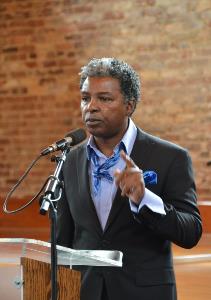Jonathan Green, Jesse Jackson Highlight HBCU Week At Claflin
Sep 28, 2015
 Claflin University celebrated HBCU (Historically Black College and Universities) Week/Panther Fest with two voices representing different but powerful perspectives on the American consciousness.
Claflin University celebrated HBCU (Historically Black College and Universities) Week/Panther Fest with two voices representing different but powerful perspectives on the American consciousness.
Internationally renowned artist Jonathan Green spoke passionately about the role of arts in everyday existence and civil rights activist Jesse Jackson cited the importance of civic responsibility, highlighting week-long activities focused on Claflin University's globalization effort and HBCU legacy.
Green’s visit to Claflin was no accident. During his speech on the Lowcountry Rice Project in Ministers’ Hall (Thursday, Sept. 24) he said that Claflin President Henry Tisdale was responsible for him visiting the campus.
“Dr. Tisdale and I have been friends for several years,” said Green, considered by many art critics to be one of the most important painters of his generation. “He said he would not speak to me again if I did not visit Claflin – so here I am.”
Green had a very busy schedule once he arrived at Claflin. He conducted lectures about his work to area high school and Claflin art students. He talked about his Lowcountry Rice Project to a group of nearly 200 listeners
“Rice is really the building block of the American civilization and culture going as far back as the 1600s,” said Green. “The Rice Culture is about the contributions of African-Americans in building this country. “It’s a shame we don’t hear more about it – even at historically black colleges and universities (HBCUs) that benefited from the economic prosperity of plantation owners who helped to build those institutions.”
Green has received international renown for his works. He combines his unique artistic genius with his romantic reflections and tributes to his experiences and observations from growing up in South Carolina’s Lowcountry. His art depicts stories with common themes that celebrate life’s journey through events that are universal and timeless.
Born in Gardens Corner, S.C., Green graduated in 1982 from The School of the Art Institute of Chicago. Green’s passion for art is perhaps matched only by his devotion to the legacy of South Carolina rice and the West African slaves who cultivated it and built Charleston and the region into one of the nation's largest and wealthiest until years after the Civil War. Green’s colorful paintings of Gullah scenes are featured in his art collections worldwide and internationally.
In 2012, Green founded the Lowcountry Rice Culture Project, which builds partnerships to explore, reveal, and reclaim the shared cultural inheritance of the Lowcountry rice industry. The project emphasizes examining the consequences of history and the meaning of heritage as a launching point for broad discussions of race, class, art, trade, history, and economics.
“The slaves who worked the rice fields were extremely efficient and intelligent,” said Green. “Their work was task labor - it included time management, monitoring weather conditions, separating water, preparing for high tides or low tides. Growing and harvesting rice was skilled labor. It was not gang labor like picking cotton or tobacco. This story was lost or hidden because it shows how slaves had the ability to think and analyze situations."
"Mr. Green's accomplishments as an artist, historian and scholar continue to make an indelible mark both nationally and globally," said Tisdale. "He has transformed how many view art and history through his superior creativity and his visionary and scholarly assessment of South Carolina's rice culture.
“We truly appreciate Jonathan visiting Claflin University and bringing his extraordinary collection to the Arthur Rose Museum. He is undoubtedly one the leading visual artist of this generation."
Green's collection of lithographs and silk screen portraits is on display at Claflin University until October 2 in the Arthur Rose Museum which is open Monday – Friday from 9 a.m. – 5 p.m. Admission is free and open to the public.
Jackson treated a capacity audience to his signature oratorical style while engaging them through a series of call and response exchanges during his speech at the International Students Association’s (ISA) Power Hour Worship Service (Wednesday/Sept. 22) in the James and Dorothy Z. Elmore Chapel.
“You owe it to your ancestors to vote,” said Jackson, a native of Greenville, S.C. “Many of your grandparents were like my grandmother and could not to vote. The vote means power. It can determine who goes to college or who goes to jail. It determines who gets jobs, proper healthcare and services to take care of our communities.”
Jackson’s appearance was made possible by the ISA and the South Carolina Voter Education Project based in Columbia. Jackson concluded his speech by asking audience members if they were registered to vote. Nearly 100 students and
Orangeburg residents completed and submitted voter registration forms to Jim Felder, executive director of the S.C. Voter Education Project.
“Some colleges and universities want to be ranked number one in football or other sports,” said Jackson. “We know Claflin is the number one HBCU. But Claflin can also be the number one HBCU in voter registration.”
Jackson’s two presidential campaigns broke new ground in U.S. politics. His 1984 campaign registered over one million new voters, won 3.5 million votes, and helped the Democratic Party regain control of the Senate in 1986.
His 1988 campaign registered over two million new voters, won seven million votes, and helped boost hundreds of state and local elected officials into office. Additionally, he won historic victories, coming in first or second in 46 of 54 primary contests.